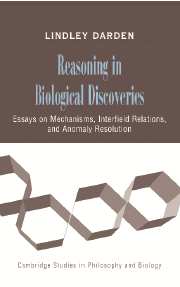 Reasoning in Biological Discoveries
Reasoning in Biological Discoveries Published online by Cambridge University Press: 31 August 2009
INTRODUCTION
Philosophers of biology have debated the nature of the relations between Mendelian genetics and molecular biology for some fifty years. They have proposed a variety of relations between the fields, including reduction, replacement, and explanatory extension. This chapter proposes a new analysis: the two fields discovered separate but serially connected mechanisms. These hereditary mechanisms have different working entities and the mechanisms operate at different times in an integrated temporal series of hereditary mechanisms. This analysis better characterizes the practice of biologists than previous accounts, as evidenced both by the historical development of the two fields and by presentations of the results of the two fields in contemporary textbooks.
Accounts of formal reduction played many roles in philosophical analyses of science in the second half of the twentieth century. Reduction was seen both as the relation among theories at different levels of organization at a given time (sometimes called “microreduction”) and as the relation between predecessor and successor theories. Furthermore, reduction was tied closely to explanation. The connection between what was to be explained (the explanandum) and what did the explaining (the explanans, usually general laws) was claimed to be (usually) deduction (Hempel 1965). Hence, the deduction of the reduced theory (or the observations that it explained) from the reducing theory in formal reduction permitted the claim that the reducing theory explained the reduced theory (or its observation statements). The status of the reduced theory after a reduction was different in different accounts of formal reduction.
To save this book to your Kindle, first ensure [email protected] is added to your Approved Personal Document E-mail List under your Personal Document Settings on the Manage Your Content and Devices page of your Amazon account. Then enter the ‘name’ part of your Kindle email address below. Find out more about saving to your Kindle.
Note you can select to save to either the @free.kindle.com or @kindle.com variations. ‘@free.kindle.com’ emails are free but can only be saved to your device when it is connected to wi-fi. ‘@kindle.com’ emails can be delivered even when you are not connected to wi-fi, but note that service fees apply.
Find out more about the Kindle Personal Document Service.
To save content items to your account, please confirm that you agree to abide by our usage policies. If this is the first time you use this feature, you will be asked to authorise Cambridge Core to connect with your account. Find out more about saving content to Dropbox.
To save content items to your account, please confirm that you agree to abide by our usage policies. If this is the first time you use this feature, you will be asked to authorise Cambridge Core to connect with your account. Find out more about saving content to Google Drive.